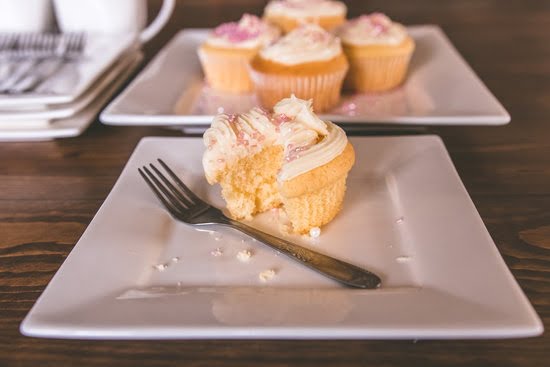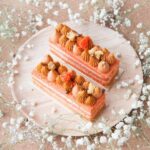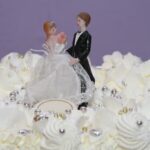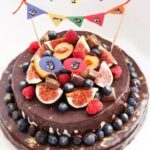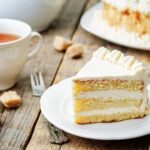Are you looking for the perfect cake recipe that not only tastes delicious but also provides a blank canvas for your decorating creativity? Look no further. In this article, we will unveil the ultimate white cake recipe specifically designed for decorating. Whether you’re a baking enthusiast or a beginner, this recipe is guaranteed to elevate your cakes to new heights.
When it comes to decorating cakes, white cake serves as the ideal foundation. Its neutral color allows for endless possibilities and provides the perfect backdrop for vibrant decorations. But not all white cake recipes are created equal – there are certain factors to consider in order to achieve a delicious and visually stunning masterpiece.
In this article, we will walk you through the process of selecting the best white cake recipe for your decorating needs. We will delve into each step of baking the perfect white cake and provide useful tips on how to ensure it turns out moist and fluffy. Additionally, we’ll reveal the secret ingredient that sets this particular recipe apart from others in terms of taste and texture.
Get ready to explore various frosting options that perfectly complement your decorated white cake. Whether you prefer buttercream, cream cheese, or ganache, we’ll guide you through choosing the best frosting to take your creation to the next level. Furthermore, we’ll share inspiring ideas and innovative techniques for decorating your white cake like a pro.
So if you’re ready to take your baking skills up a notch and amaze everyone with your beautifully decorated white cakes, let’s dive into the world of the best white cake recipe for decorating.
Why is white cake the perfect canvas for decorating?
White cake is often considered the perfect canvas for decorating because of its simplicity and versatility. The neutral color of white cake allows for endless possibilities when it comes to decorating, as it can be easily paired with a wide range of frosting flavors and colors. Whether you are creating a whimsical birthday cake or an elegant wedding cake, white cake provides a visually pleasing background that allows your decorations to shine.
Versatility in Design
One of the main reasons why white cake is so popular for decorating is its versatility in design. The blank canvas of white cake allows bakers and decorators to let their creativity run wild. From simple buttercream swirls to intricate fondant designs, there are countless ways to transform a plain white cake into a work of art. White cake also provides an ideal backdrop for adding vibrant edible decorations such as sprinkles, sugar flowers, or edible gold leaf.
Showcasing Colors and Flavors
Another reason why white cake is favored for decorating is its ability to showcase both colors and flavors. By using different types of frosting, food coloring, and flavorings, bakers can create eye-catching cakes that not only look stunning but taste delicious too.
The light and airy texture of white cake pairs well with a variety of frosting flavors such as vanilla, chocolate, lemon, raspberry, or even coconut. These different flavors can enhance the overall taste experience while complementing the decorative elements on the cake.
An All-Occasion Favorite
White cakes are often chosen for special occasions due to their timeless appeal and wide acceptance among all age groups. Whether it’s a birthday party, wedding reception, anniversary celebration or baby shower, a beautifully decorated white cake always adds a touch of elegance and sophistication to any event. Furthermore, since white is associated with purity and new beginnings, it makes it an ideal choice for weddings where tradition often dictates a white wedding cake.
Overall, the perfect canvas provided by white cake allows decorators to showcase their skills and create stunning edible masterpieces. Its versatility, ability to showcase colors and flavors, and wide acceptance make white cake a popular choice for any occasion that calls for a visually appealing and delicious centerpiece. So next time you’re looking to decorate a cake, consider using a white cake recipe as your base to truly elevate your decorating skills.
Factors to consider when selecting the best white cake recipe for decorating
When it comes to selecting the best white cake recipe for decorating, there are several factors to consider. The texture, taste, and stability of the cake are all important elements that can make or break your decorating efforts. Here are some key factors to keep in mind when choosing a white cake recipe for decorating:
Moisture and Fluffiness
A moist and fluffy cake is essential for a successful decorating project. Look for recipes that include ingredients like buttermilk or sour cream, as these can help add moisture to the cake. Additionally, recipes that call for separating the egg yolks from the whites and whipping them separately can result in a lighter and fluffier texture.
Stability
A sturdy cake is crucial when it comes to decorating as it needs to support icing, fillings, and any additional decorations you may add. Opt for recipes that have a good amount of structure such as those that use cake flour instead of all-purpose flour. A denser yet still tender crumb will provide the stability needed for your decorations.
Flavor
While white cakes are often chosen for their neutral color that allows decorations to shine, don’t forget about flavor. Look for recipes that incorporate flavors such as vanilla or almond extract to enhance the taste of your cake.
Allergies and Dietary Restrictions
Consider any dietary restrictions or allergies you or your guests may have when selecting a white cake recipe for decorating. Fortunately, there are numerous alternatives available these days such as gluten-free or vegan options that can cater to different dietary needs without compromising on taste or texture.
By taking these factors into account when selecting a white cake recipe for decorating, you can ensure that your creation not only looks stunning but also tastes delicious and holds up well during decorating and serving. Experiment with different recipes until you find the perfect one that meets all of your requirements.
A step-by-step guide to baking the perfect white cake
Baking a perfect white cake is not as daunting as it may seem. With the right ingredients and techniques, you can create a moist and fluffy cake that will serve as the perfect canvas for your decorating dreams. Follow this step-by-step guide to ensure success with your white cake baking.
Step 1: Gather Your Ingredients
Before you begin, make sure you have all the necessary ingredients on hand. For a basic white cake recipe, you will need all-purpose flour, baking powder, salt, unsalted butter, sugar, vanilla extract, milk, and egg whites. It’s important to use room temperature ingredients for optimal results.
Step 2: Preparing the Batter
Start by sifting together the flour, baking powder and salt in a large mixing bowl. In a separate bowl or stand mixer, cream together the butter and sugar until light and fluffy. Add in the vanilla extract and gradually mix in the dry ingredients alternately with the milk. Be careful not to overmix at this stage as it can lead to a dense texture.
Step 3: Beating Egg Whites
Separate your egg whites from the yolks in a clean mixing bowl. Beat the egg whites until stiff peaks form. Gently fold them into the cake batter using a spatula or whisk. This step helps to give your white cake its light and airy texture.
Step 4: Baking and Testing for Doneness
Preheat your oven to the recommended temperature specified in your recipe. Grease and flour your cake pans before evenly dividing the batter between them. Bake for the recommended time or until a toothpick inserted into the center of each cake comes out clean.
Remember that oven temperatures can vary, so keep an eye on your cakes towards the end of their baking time to prevent overbaking. Once baked, allow the cakes to cool completely before removing them from the pans.
Step 5: Leveling and Storing
To ensure a flat surface for decorating, use a serrated knife or cake leveler to trim off any domed tops of your cakes. If you are not decorating immediately, tightly wrap the cooled cakes in plastic wrap and store them in the refrigerator until ready to use. This will help retain moisture and keep your cake fresh.
By following these steps, you can easily bake a perfect white cake that is ready for decorating. Remember to experiment with flavors and fillings that complement your design. With practice, you’ll soon be creating stunning masterpieces that taste as good as they look.
Top tips for achieving a moist and fluffy white cake
Achieving a moist and fluffy white cake is essential for creating the perfect canvas for your decorating masterpiece. Here are some top tips to help you achieve that desired texture and taste:
- Use Cake Flour: Swap out the all-purpose flour for cake flour in your recipe. Cake flour has a lower protein content, which results in a lighter and more tender cake crumb.
- Cream the Butter and Sugar Properly: Creaming the butter and sugar until light and fluffy incorporates air into the batter, creating a lighter texture. Make sure to beat them together for at least 3-4 minutes until pale in color.
- Don’t Forget the Sour Cream or Buttermilk: Incorporating sour cream or buttermilk into your white cake batter adds moisture and tanginess. These ingredients also help tenderize the gluten in the flour, resulting in a softer texture.
- Use Room Temperature Ingredients: It’s important to use room temperature eggs, milk, and butter when baking your white cake. Cold ingredients can result in an uneven texture and reduce overall volume.
- Don’t Overmix the Batter: Once you add the dry ingredients to the wet mixture, be careful not to overmix as it can lead to a dense and tough cake. Mix until just combined to avoid overworking the gluten.
- Add Flavor Enhancers: While white cakes are known for their simplicity, adding flavor enhancers like vanilla extract or almond extract can elevate its taste without overpowering it.
| Tips | Description |
|---|---|
| Use Cake Flour | Cake flour has a lower protein content, resulting in a lighter texture. |
| Cream the Butter and Sugar Properly | Creaming creates a lighter texture by incorporating air into the batter. |
| Don’t Forget the Sour Cream or Buttermilk | Sour cream or buttermilk add moisture and tenderize the gluten in the flour. |
| Use Room Temperature Ingredients | Cold ingredients can result in an uneven texture and reduced volume. |
| Don’t Overmix the Batter | Overmixing leads to a dense and tough cake, so mix until just combined. |
| Add Flavor Enhancers | Vanilla extract or almond extract can enhance the taste without overpowering it. |
By following these tips, you’ll be able to achieve a moist and fluffy white cake that will provide a perfect foundation for your decorating endeavors. Remember to experiment with different flavors and decorations to create a truly unique and delightful dessert that will leave everyone impressed.
The secret ingredient that sets this white cake recipe apart from the rest
One of the key elements that sets this white cake recipe apart from others is the secret ingredient that adds an extra touch of flavor and moisture. While traditional white cakes typically use ingredients such as flour, sugar, butter, and eggs, this recipe goes a step further by incorporating sour cream into the batter. The addition of sour cream gives the cake a tangy richness and creates a moist texture that is perfect for decorating.
Here is a step-by-step guide to incorporating the secret ingredient into your white cake:
- Start by gathering all the necessary ingredients: flour, sugar, butter, eggs, vanilla extract, baking powder, baking soda, salt, milk, and sour cream.
- In a mixing bowl, cream together the butter and sugar until light and fluffy.
- Add in the eggs one at a time, beating well after each addition. This ensures that they are fully incorporated into the batter.
- In a separate bowl, whisk together the dry ingredients – flour, baking powder, baking soda, and salt – making sure they are evenly combined.
- Slowly add in half of the dry ingredients to the butter mixture while alternating with half of the milk. Mix until just combined.
- Add in the remaining dry ingredients followed by the remaining milk. Mix until all ingredients are fully incorporated.
- Finally, fold in the sour cream gently using a spatula or wooden spoon until it is evenly distributed throughout the batter.
By adding sour cream to your white cake batter, you not only enhance its flavor but also create a tender and moist texture that will make your decorated cake truly unforgettable.
To achieve maximum moisture and fluffiness in your white cake recipe:
- Use room temperature ingredients: Make sure to take out all your refrigerated ingredients like butter and eggs ahead of time so they can come to room temperature before being used in your batter.
- Avoid overmixing: Overmixing can lead to a dense and tough cake. Mix your ingredients just until they are fully incorporated to ensure a light and fluffy texture.
- Do not overbake: White cakes tend to dry out quickly if left in the oven for too long. Bake the cake until a toothpick inserted into the center comes out clean and remove it promptly from the oven.
With these tips and the secret ingredient of sour cream, you can make sure that your white cake turns out moist, fluffy, and perfect for all your decorating endeavors.
Best frosting options to pair with your decorated white cake
One of the key factors in creating a delicious and visually stunning decorated white cake is choosing the perfect frosting to pair with it. The right frosting can enhance the flavors of the cake and provide a smooth and beautiful canvas for your decorations. In this section, we will explore some of the best frosting options that you can consider when decorating your white cake.
- Buttercream Frosting: Buttercream is one of the most popular choices for decorating cakes due to its versatility and delicious taste. It is made using butter, powdered sugar, vanilla extract, and a small amount of milk or heavy cream. Buttercream can be easily tinted with food coloring to create vibrant colors for your decorations. It also holds up well in warmer temperatures, making it ideal for outdoor events.
- Cream Cheese Frosting: If you’re looking for a tangy and creamy option, cream cheese frosting is an excellent choice. Made with cream cheese, butter, powdered sugar, and vanilla extract, this frosting pairs perfectly with a light and fluffy white cake. Cream cheese frosting can be piped into intricate designs or smoothed over the entire cake for a more rustic look.
- Swiss Meringue Buttercream: Swiss meringue buttercream is known for its silky texture and light sweetness. It is made by whisking egg whites and sugar over simmering water until they reach 160°F (71°C) and then beating them until stiff peaks form. Softened butter is gradually added to create a smooth frosting that is perfect for piping delicate designs on your white cake.
These are just a few options to consider when selecting the best frosting for your decorated white cake. Each type of frosting has its own unique qualities that can complement different flavor profiles and design styles. Don’t be afraid to experiment with different combinations to find the perfect match for your cake.
| Frosting Option | Key Characteristics |
|---|---|
| Buttercream Frosting | Versatile, delicious, holds up well in warmer temperatures |
| Cream Cheese Frosting | Tangy, creamy, pairs well with a light and fluffy white cake |
| Swiss Meringue Buttercream | Silky texture, light sweetness, perfect for piping delicate designs |
Inspiring and innovative decorating ideas for your white cake
White cakes provide the perfect blank canvas for creativity and decoration. Once you have mastered the art of baking a moist and fluffy white cake, it’s time to let your imagination soar with inspiring and innovative decorating ideas. Whether you’re looking to create a whimsical birthday cake or an elegant wedding cake, these ideas will help you take your white cake to the next level.
One popular technique for decorating a white cake is using edible flowers. Fresh flowers can add a touch of natural beauty to any cake design. Some commonly used edible flowers include roses, pansies, lavender, and violets. Make sure to select flowers that are safe for consumption and free from pesticides. Gently wash the flowers before using them as decorations on your cake.
Another trendy decorating idea for white cakes is using geometric shapes. You can create intricate patterns by cutting fondant or modeling chocolate into triangles, squares, or hexagons. These geometric shapes can be arranged in different ways to achieve stunning visual effects on your white cake. Experiment with various color combinations and sizes to add depth and dimension to your design.
If you’re looking for a more whimsical approach, consider incorporating edible glitter or luster dust into your decorating scheme. These edible powders come in an array of colors and can be brushed onto your white cake to give it a magical sparkle. They can be used on their own or mixed with vodka or lemon extract to create a paint-like consistency for more intricate designs.
| Decorating Technique | Description |
|---|---|
| Edible Flowers | Adding fresh flowers as decorations |
| Geometric Shapes | Incorporating cut fondant or modeling chocolate |
| Edible Glitter/Luster Dust | Adding a sparkle with edible powders |
These are just a few examples of the many ways you can decorate a white cake. Don’t be afraid to let your creativity shine and try out different techniques and ideas. The key is to have fun and make it your own. So go ahead, unleash your inner artist and transform your white cake into a work of art that not only tastes delicious but also looks visually stunning.
Mastering the art of piping and creating intricate designs on your white cake
Piping is an essential skill when it comes to decorating a white cake. It allows you to create intricate designs and add beautiful accents that can elevate the overall appearance of your cake. With practice and the right techniques, you can master the art of piping and create stunning decorations on your white cake.
To start piping, you will need a piping bag and different tips depending on the design you want to achieve. Here are a few popular piping tips and their uses:
- Round Tip (Tip 2): This tip is perfect for creating dots or writing messages on your white cake.
- Star Tip (Tip 16): The star tip creates beautiful rosettes, swirls, or stars on your cake’s surface.
- Leaf Tip (Tip 352): If you want to add delicate leaves or petals to your design, the leaf tip is ideal.
Before you begin piping, it’s important to practice your technique. You can do this by piping on a smooth surface such as parchment paper until you feel confident in creating even pressure and consistent lines. Once you’re ready to pipe directly onto your cake, make sure it has cooled completely so that the icing doesn’t melt.
When it comes to actually piping onto your white cake, remember that slow and steady wins the race. Start by applying gentle pressure to your filled piping bag while guiding it along the desired path for your design. If you make any mistakes or want to change directions mid-pipe, simply lift the bag away from the cake and start again.
With practice and patience, you will be able to create stunning designs such as flowers, borders, intricate patterns, or even personalized messages on your white cake. Experiment with different colors of frosting and various piping techniques to further enhance the beauty of your decorated masterpiece.
Mastering the art of piping takes time and practice, but with dedication and creativity, you will be able to create intricate and eye-catching designs on your white cake. So, don’t be afraid to experiment and let your imagination run wild as you turn your plain white canvas into a work of edible art.
Frequently asked questions about decorating white cakes
White cakes are a popular choice for decorating due to their versatile nature and ability to showcase intricate designs. As you embark on your journey of creating beautifully decorated white cakes, you may have some questions along the way. Here are some frequently asked questions about decorating white cakes:
How do I prevent my white cake from drying out?
One of the biggest concerns when it comes to baking a white cake is keeping it moist and fluffy. To prevent your cake from drying out, here are a few tips:
- Be sure not to overmix the batter as this can lead to a dense and dry cake.
- Use buttermilk or sour cream in the recipe to add moisture and enhance the flavor.
- Bake the cake at the correct temperature and timing specified in the recipe.
- Once baked, wrap the cake tightly in plastic wrap or store it in an airtight container.
Can I freeze a decorated white cake?
Yes, you can freeze a decorated white cake. Freezing can be a convenient way to prepare in advance for special occasions or events. To freeze a decorated white cake, follow these steps:
- Allow the decorated cake to completely cool before freezing.
- Place the cake on a flat surface or cardboard base and carefully wrap it in plastic wrap.
- To further protect against freezer burn, place the wrapped cake in an additional layer of aluminum foil or place it inside an airtight container.
- Thaw the frozen cake by placing it in the refrigerator overnight. Avoid thawing at room temperature as this can cause condensation.
How long in advance can I prepare a decorated white cake?
Decorating a white cake requires time and effort, and sometimes it’s helpful to prepare certain elements ahead of time. Here are some guidelines for preparing a decorated white cake in advance:
- Baking: You can bake the cake layers a day or two in advance, as long as you wrap them tightly in plastic wrap and store them at room temperature.
- Frosting: Many frostings can be prepared a day ahead and stored in the refrigerator. Just make sure to bring the frosting to room temperature before using it.
- Assembly: It is best to assemble and decorate the white cake on the same day you plan to serve it. However, if you need to assemble it earlier, avoid adding perishable fillings or decorations that may spoil.
As you continue your white cake decorating journey, keep these frequently asked questions in mind. With practice and experimentation, you’ll become more confident in creating beautifully decorated white cakes that not only look stunning but taste delicious too.
Conclusion
In conclusion, if you are looking to elevate your baking skills and create stunning decorated cakes, the best white cake recipe is the ideal starting point. White cake serves as the perfect canvas for decorating because of its light and neutral color, allowing your creativity to shine through in the design.
With a few key factors to consider when selecting a recipe and some top tips for achieving the perfect texture, you can confidently embark on your journey to create beautiful and delicious white cakes.
One of the secrets to making an exceptional white cake lies in following a step-by-step guide that ensures every element is executed with precision. From measuring the ingredients accurately to properly mixing and baking the batter, attention to detail is crucial.
By using a tried-and-true recipe that has been tested and perfected by experienced bakers, you can trust that you are on the right path towards creating a moist and fluffy white cake that will impress anyone who takes a bite.
While there are many frosting options available for pairing with your decorated white cake, it is important to choose one that complements both the flavor and aesthetic of your creation. From classic buttercream to rich cream cheese frosting or even a luscious ganache, each option offers its own unique taste profile that can enhance your cake’s overall appeal. Experimenting with different flavors and textures will allow you to discover creative combinations that showcase your personal style.
With this article as your guide, along with some practice mastering piping techniques and creating intricate designs, you will soon be able to achieve professional-looking decorations on your white cakes. Whether it is elegant flowers, delicate patterns, or personalized messages, learning the art of piping opens up endless possibilities for expressing your creativity. By continually challenging yourself and experimenting with new ideas, you will become adept at transforming simple white cakes into edible works of art.
So why wait? Start honing your baking skills today by trying out the best white cake recipe for decorating. With dedication and practice, you will soon be able to create visually stunning cakes that not only dazzle the eyes but also delight the taste buds. Elevate your baking game and let your artistic talents shine with the versatile and delightful white cake as your canvas.
Frequently Asked Questions
What is the difference between white cake and vanilla cake?
The main difference between white cake and vanilla cake lies in their flavors. White cake is a type of cake that is made using only egg whites, resulting in a pure white color and a light, delicate texture. It typically has a subtle flavor with a slight hint of vanilla or almond extract.
On the other hand, vanilla cake is made using whole eggs or egg yolks along with the egg whites, giving it a slightly off-white color compared to white cake. Vanilla cake has a richer flavor profile, predominantly deriving its taste from the addition of pure vanilla extract.
What is the best boxed white cake mix?
Determining the best boxed white cake mix can be subjective and depends on personal preferences. However, some popular options among consumers include Betty Crocker Super Moist White Cake Mix and Pillsbury Classic White Cake Mix.
Both of these brands are known for producing consistently good results with moist and fluffy cakes. It’s always helpful to read reviews or ask for recommendations from friends and family who have tried different types of boxed white cake mixes to find the one that suits your taste buds.
What is the secret to a perfect cake?
The secret to a perfect cake lies in paying attention to the details throughout the baking process. Firstly, accurate measuring of ingredients is crucial as even slight variations can affect the final outcome. It’s essential to follow the recipe closely and measure ingredients using proper measuring tools such as cups or scales for precise quantities.
Secondly, mixing the batter properly is vital to ensure all ingredients are well combined without overmixing which could lead to a dense or tough texture. Additionally, properly preheating the oven before baking ensures even heat distribution for consistent results. Finally, closely monitoring baking time and inserting a toothpick into the center of the cake to check for doneness are important steps to avoid under- or over-baking your masterpiece.

Welcome to our cake decorating blog! My name is Destiny Flores, and I am the proud owner of a cake decorating business named Cake Karma. Our mission is to provide delicious, beautiful cakes for all occasions. We specialize in creating custom cakes that are tailored specifically to each customer’s individual needs and tastes.

